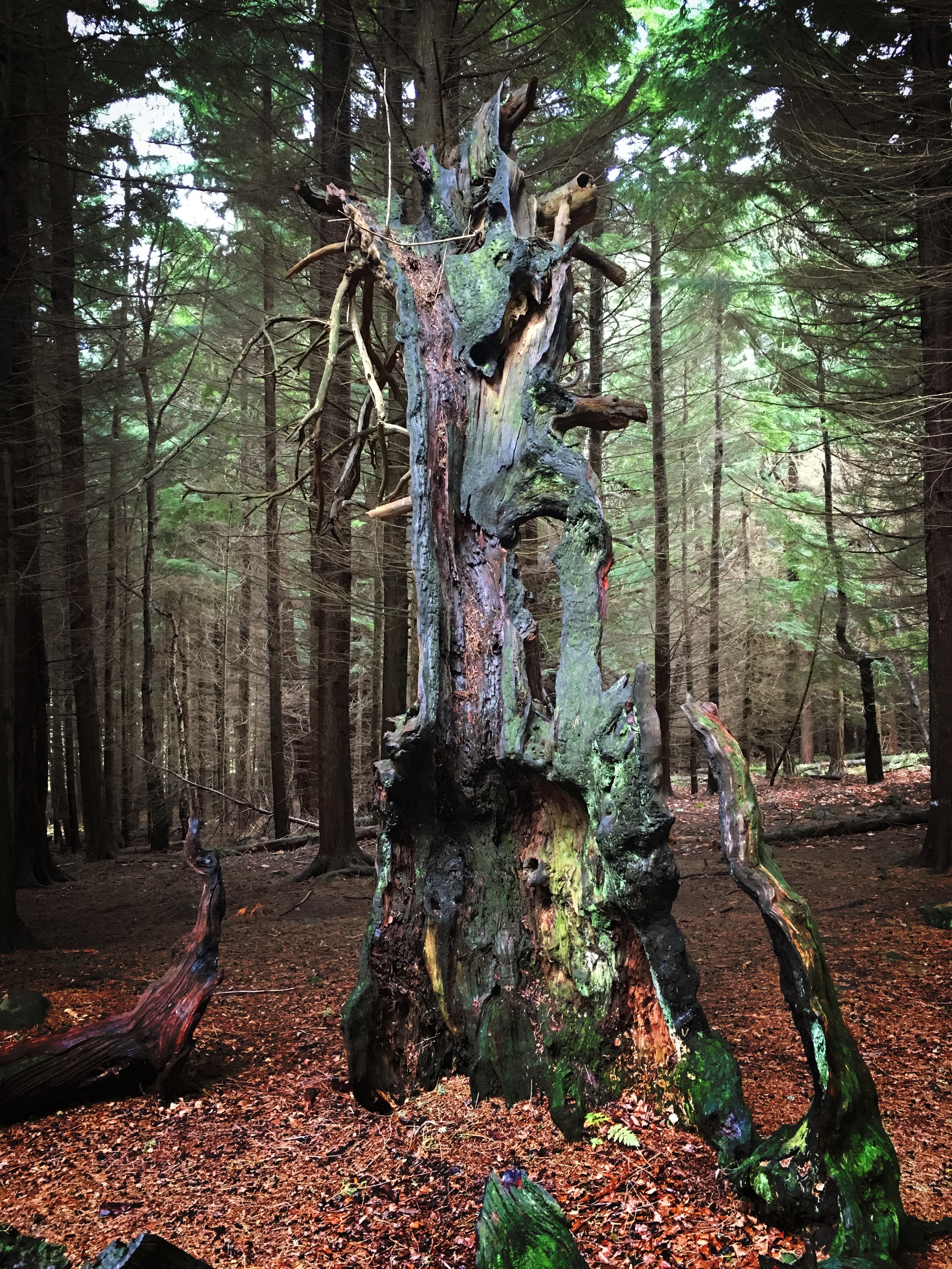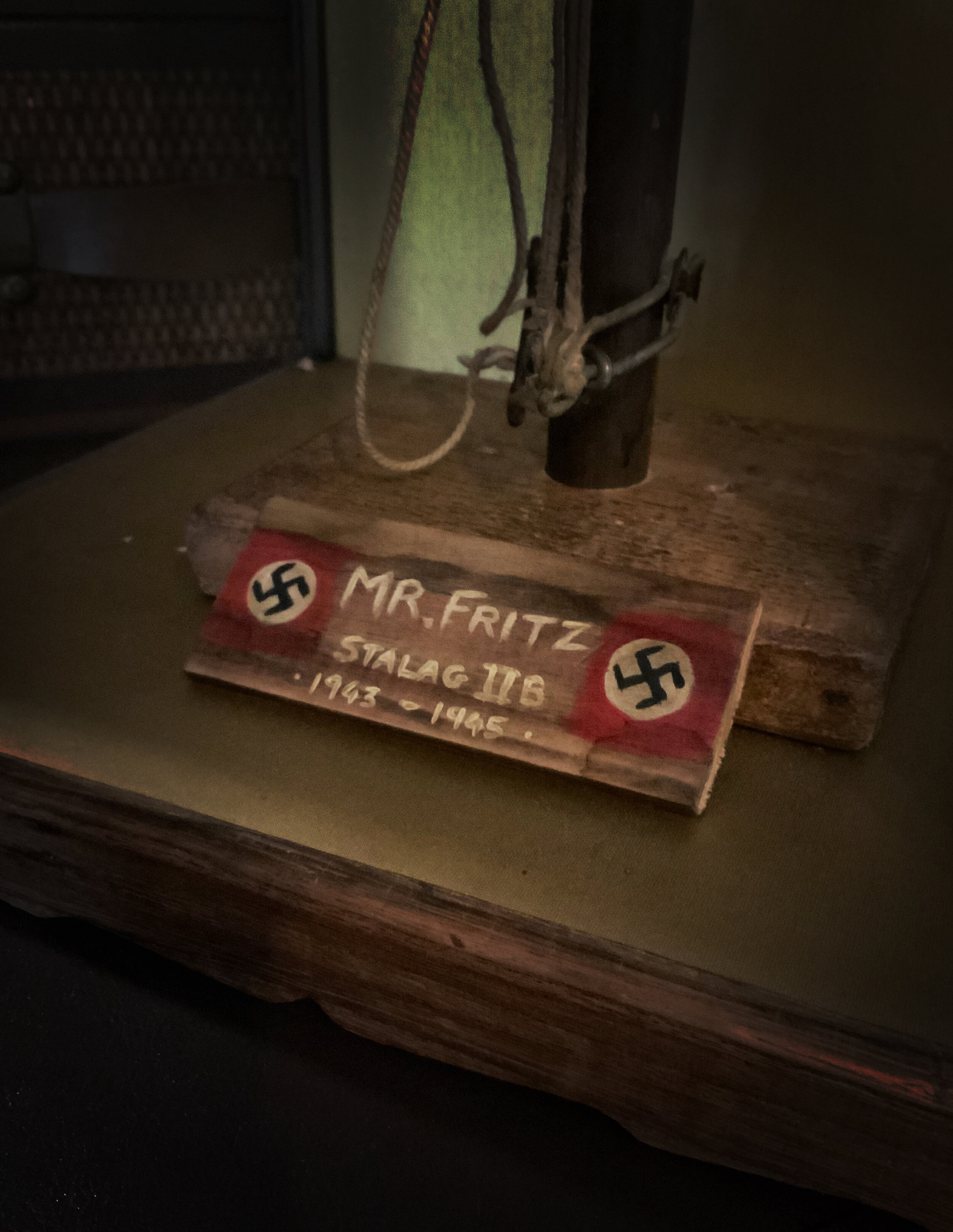The disturbing tale of Mr Fritz – the haunted ventriloquist dummy of Stalag IIB
Halloween and Remembrance Day are a mere eleven days apart so it seems only fitting that I post this story regarding two of the most terrifying things a person should never have to encounter during their life – war and ventriloquist dolls.
The private collection of alternative entertainer Michael Diamond is home to some of the rarest sideshow exhibits and apparatus in the UK. Oddities such an elephant headed boy from Brading Waxwork Museum, real execution swords and axes, Houdini's handcuffs and shrunken heads are all on display in his 'Freak Room'. But tucked away in the corner, shrouded in a blanket is a display cabinet with a firmly locked door. The 'Freak Room' is now the final resting place of Mr Fritz, a haunted ventriloquist doll, who has struggled to find a home since 1945.
Not much remains of Mr Fritz. A solitary head, mounted on a piece of wooden pace stick, his face peeling and warped. As dead as he looks, some would argue that he is very much alive. Unlike most of the exhibits in Michael's collection which were acquired through considerable financial investment, Mr Fritz was given to him for free. Michael admits though that this was not initially unusual,
“Most people find dolls, especially ventriloquist dolls far too creepy. The unlucky ones end up being thrown out or locked in attics for years while others get given to collectors like myself”.
A well know WWII Militaria dealer in Liverpool approached Michael at a festival they were both working at over the summer. He had seen Michael’s travelling exhibition of oddities and thought that Mr Fritz would fit in perfectly. Mr Fritz was discovered in an Antiques Mall in Myrtle Beach, USA and once the dealer heard of the connection with a German POW camp he felt compelled to buy him and bring him to the UK. It was then that things started to happen.
The dealer, who wishes to remain anonymous, first started to notice something strange when he put Mr Fritz on display in his showroom. He would lock up for the night and come back in the morning to discover that Mr Fritz's display case door was wide open, even after it had been firmly shut. Every night it would be shut, yet every morning it would be open again. Things then started to take a more uncanny turn. Mr Fritz would sometimes have his eyes open, when they were normally closed. His mouth would also change position. The dealer tried to think of obvious explanations such as humidity, a breeze or even going as far to think that a mouse may have made a nest in his head. On closer inspection, he discovered it was neither of these things. Day after day the door continued to open so he finally taped it shut. The following day he returned to find the tape peeled back and the door open once more. He finally removed Mr Fritz from the showroom and placed him in the garden shed where he stayed for another six months. His children then reported hearing laughter from the shed as they played in the garden and nobody would dare go near it.
Mr Fritz had to go.
As soon as Michael adopted the lonesome remains of Mr Fritz, he placed him in the 'Freak Room' and immediately things started to happen. The door started to open. At first it was once or twice a week but soon the door opened every night without fail. He even discovered one morning that the display case was not only open but had moved six inches across the table. Curiosity finally got the better of Michael and he set up a GoPro camera to monitor Mr Fritz. As you might imagine, a doll that was made to entertain people was not camera shy and the following footage was shot over two nights in September 2019.
But what is the story behind Mr Fritz?
A small hand written note that accompanied the eerie doll explained that he was originally a ventriloquist doll who was used to entertain Allied POWs during WWII in Stalag IIB between 1943 – 1945.
Stalag II-B was a German POW camp situated 2.4 kilometres west of the village of Hammerstein in Poland. In 1933 it was established as one of the first Nazi concentration camps and was used to house German communists. In late September 1939 the camp was changed to a POW camp to house Polish soldiers and in August 1943 the first American prisoners arrived, having been taken prisoner in the Tunisian campaign. Over 600 US POWs were held in Stalag IIB and life was harsh, consisting of long days of hard labour on neighbouring farms with meagre rations.
Prisoners tried to overcome these hardships by educating themselves and staging entertainments such as musicals and comedy. Among the prisoners with enough energy to entertain was Private 'Billy' Booth who had been a children's entertainer and puppeteer before the war started. He had made Mr Fritz with German newspapers soaked in potato starch and painted him with a smuggled pot of pink gloss that a Polish farmer had given him which had been used to paint his daughter's cot.
For almost 18 months Billy Booth and Mr Fritz entertained the prisoners of Stalag IIB with 'in' jokes and songs. He was so good that even some of the German guards found him funny. But unfortunately on 14th January 1945, 2 weeks before the camp was liberated, Billy and nine other US POWs were taken into a field, made to dig a large pit and shot for not working hard enough.
When the camp was finally liberated on 28th January 1945, Mr Fritz was taken back to the US by a fellow prisoner and given to Billy Booth's family as a reminder of their son's fortitude and his ability to raise morale in the harshest conditions.
Lest we forget.
How Mr Fritz ended up in a US antiques mall is not know, did Billy Booth's family give him away or was he thrown out for being too 'lively'? These things we will never know. All we do know is that what remains of Billy Booth's creation is safely tucked away in Michael Diamond's 'Freak Room' where he shall remain for the unforeseeable future. And if Billy wants to open Mr Fritz's cabinet every now and again to reminisce days gone by, then Michael doesn't have a problem with that.
John Murray Spear's 'Mechanical Messiah' Discovered in Colorado Attic
In 1854, an experiment far stranger than anything in Mary Shelley’s novel took place when a New England clergyman married science and spiritualism in an attempt to build nothing less than a god. Discovered in a dusty attic in Colorado, could this be John Murray Spear’s fabled ‘God Machine’ or ‘New Motive Power’?
Those familiar with the Lore podcast may have heard of this bizarre machine in Episode 61 ‘- Labor Pains’. In 1853 work began on a mysterious machine, an experiment that has since become synonymous with the early spiritualist movement. If successful, it was believed that the machine in question had the power to “revolutionize the world and raise mankind to an exalted level of spiritual development.” It was thought that once finished, the machine itself would act as a physical body for God, a metal and copper suit to contain the divine spark. They called it the New Motive Power; Heaven’s last, best gift to man.
An Early Etching of the Mechanical Messiah
What eventually happened to this machine has become the source of legend and speculation. According to Spear, the Machine was dismantled and transported hundreds of miles to the small town of Randolph. There it was housed in a temporary structure until a mob - in a scene reminiscent of the peasants storming Frankenstein’s castle - destroyed it. However, over the years, those who believe in the creation of the God Machine have surmised that Spear and his group fabricated the destruction of the machine with the hopes of drawing negative attention away, sacrificing their credibility for the safety of the infant creation. They believe that it still exists somewhere, slowly gaining strength after one-hundred and fifty-six years in seclusion, and that one day, it will unveil itself to humanity in it’s true form : the second coming of Christ; the Metal Messiah.
Even more of a mystery if how the machine made the journey from Randolph to Colorado where it laid undiscovered for over a century. The age and likeness to the early etchings point to the possibility that this could well be the genuine ‘God Machine’. It was found during the routine house clearance of an elderly lady who sadly died with no next of kin or immediate family. Miss Akerman of Greeley, Colorado, known locally as ‘Old Lady Crackerman’ due to her eccentricity was a habitual hoarder and lived a rambling mansion on the edge of town which became home to her vast antique collection. In her will she instructed that in the event of her death, the house be cleared and all of the contents auctioned with the proceeds being donated to local pet rescue charities.
The God Machine was discovered during the final stages of clearance which had taken over 3 week to catalogue. In a locked attic in the furthest corner of the mansion, a drab stained dust sheet covered a mysterious object that would later baffle the local antique experts charged with valuing Miss Ackerman’s extensive collection.
The only clue to the origin of steampunk contraption was a brass plate engraved with ‘New Motive Power - John Murray Spear’. A quick Google search revealed that they had uncovered something that was rumored to have been destroyed over a hundred years ago.
The mass of brass cogs, dials, glass cylinders and strange clockwork systems looks like a steampunk wet dream, yet this was built long before the questionable fashion of top hats, goggles and clockwork powered laser guns was born.
So the big question is, does it work? Is this the real ‘New Motive Power’, the ‘God Machine, the ‘Mechanical Messiah’?
As far we know, the machine has been loaned from the Ackerman estate to a local Spiritualism expert where it is being tested for its authenticity. Watch this space for more news.
The Fairy Census: 2014 – 2017 is out
British and Irish fairies have been around since 500 AD. Ever since the Cottingley Fairy Hoax (1917-21) they have been in decline, however. In the footsteps of The Lord of the Rings and The Game of Thrones, British fairies are regaining their old lustre. Did you know that many British fairies don’t have wings and can be the size of a leaf or up to 15 foot tall?
The Fairy Census is an attempt to gather, scientifically, the details of as many fairy sightings from the last century as possible and to measure, in an associated survey, contemporary attitudes to fairies. The census was inspired by an earlier fairy census carried out by Marjorie Johnson and Alasdair Alpin MacGregor in 1955/1956, a census that was published in 2014.
Simon Young has offered a copy of this incredible survey for FREE!
Do download your copy now.
If you wish to submit your own sighting for the next census there are two (anonymous) census forms: one for witness accounts and one for second-hand accounts (experiences of grandma, uncle, friend etc). Confidentiality is assured and, in the case of publication, personal details will be changed to assure anonymity. Note, however, that by filling out these forms you approve their use in an academic survey.
1) If you witnessed the event first-hand click here
2) If you are describing an event experienced by someone else click here
There is also a general survey on individual beliefs about fairies, using an innovative visualisation technique. Here no experience or witness account is necessary: anyone can fill out the survey who understands the word ‘fairy’. Adults are welcome to lead children through the questions, even children as young as three or four.
3) If you want to do the survey on fairy belief more generally click here.
The Most Mysterious Mansion in London
A wonderful article taken from one of my favourite blogs MessyNessyChic and if you've got a spare £3 million all this could be yours...
Malplaquet House is one of those places that makes everyone in the neighbourhood, or anyone walking past its mysterious overgrown gates, wish they could get a look inside. A home worthy of Miss Havisham herself, until recently this stellar cabinet of curiosities was one of London’s forgotten mansions, uninhabited for over a century, heading towards a fate of demolition…
In the 90s, the four-story Georgian mansion on Mile End Road was rescued by the Spitalfields Trust and became a Grade II listed building. Malplaquet House had even more luck when it fell in to the hands of the best possible buyers imaginable. Enter Tim Knox, British historian, former director of Sir John Soane’s Museum, (another restored London time capsule) and now director of the Fitzwilliam Museum in Cambridge. Together with the renowned landscape gardener Todd Longstaffe-Gowan, these two passionate collectors purchased the 275 year-old East London ruin from the Trust for £250,000. A monumental restoration project began.
Over three centuries, the house had been extensively altered up until its last domestic residents were recorded in 1895. In the 1850s, Malplaquet had seen the last of its wealthy tenants and was divided up into smaller lodgings and two shops were built upon the old front garden. Most of the double-fronted property would eventually just end up as storage space for the shops. When Tim and Todd came along in 1998, they had their work cut out for them.
“Guided by historic documentation and surviving evidence, the forecourt shops were demolished, revealing the house surprisingly intact,” says Fyfe Mcdaid, the estate agency now listing the home for £2,950,000. “Since then the owners have carefully restored the building and its garden setting, making Malplaquet House one of the most unforgettable secret houses of London.”
Unforgettable, spellbinding, thrilling romantic: these are all words that have been used to describe Malplaquet. Before the house went on sale, a local blogger, “The Gentle Author” visited the mysterious mansion and published his account along with some stellar photographs taken by Philippe Debeerst.
"Hovering nervously on the dusty pavement with the traffic roaring around my ears, I looked through the railings into the overgrown garden and beyond to the dark windows enclosing the secrets of this majestic four storey mansion (completed in 1742 by Thomas Andrews). Here I recognised a moment of anticipation comparable to that experienced by Pip, standing at the gate of Satis House before being admitted to meet Miss Havisham. Let me admit, for years I have paused to peek through the railings, but I never had the courage to ring the bell at Malplaquet House before".
And down will come baby, cradle and all... The Betty Kenny Tree
This weekend my son and I headed to Shining Cliff Woods in search of the Betty Kenny Tree. This tree is reputed to be over two thousand years old and has a very interesting story attached. This ancient yew tree claims to be the origin of the nursery rhyme "Rock a bye baby". The story has been well documented and relates to a family of charcoal burners called Luke & Kate Kenyon from the 1700s. They lived in the woods and used the tree as shelter and brought up their 8 children never once stepping foot in a conventional house. Betty would place the babies in the hollow of a branch and rock them to sleep as she worked making charcoal in the forest.
Ironically the path we took is called The Betty Kenny Trail yet it does not lead to the tree nor tell you where it is. I had seen pictures of it before so I know it was in an elevated position in an area of evergreen forest. The area was wet and cold plus the surrounding trees provided no cover so we headed up hill, deeper into the forest away from the river. We eventually reached a dry stone wall that marked the boundary between a patch of moorland and the forest. We decided to follow the wall and then I knew we had reached the right area.
The forest to the right of me became incredibly dense and dark, I commented to my son that it was the darkest I had ever seen. With a thick evergreen canopy and the trees so tightly packed, the light from the midday sun could barely penetrate the forest floor. It was Tolkien's Mirkwood made real. The outside temperature was a bracing 2.5 degrees C yet the forest became strangely humid and muggy as we ventured deeper into the darkness. The anechoic blanket of pine and yew felt like a protective shelter from the imminent snow and wind.
We finally found the Betty Kenny tree. In the 1930s the tree had been burnt by vandals so the huge space once occupied by the ancient yew was now empty and open to the sky. The light from above the forest floodlit the tree's remains like a UFO tractor beam. In the darkness of the forest it was impossible to miss.





It was hard to imagine that anyone could live for over a century in this forest let alone raise a family of eight children, one of which is still buried beneath the remains of the tree. It's an eerie spot and other worldly when you stop for a moment and try to imagine what the tree has lived through. And it is still alive, despite being used as a home and almost completely destroyed by fire. With new shoots protruding from the shattered stump it is as if the sympathetic forest does not grow over and shadow the old tree, yet instead allow the light from above through to keep it alive.
The Betty Kenny tree is a special place and one worth visiting if you don't mind wandering from the beaten track...
And you're not afraid of the dark.





























